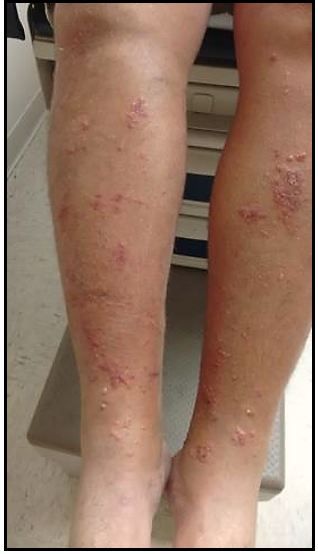- Clinical Technology
- Adult Immunization
- Hepatology
- Pediatric Immunization
- Screening
- Psychiatry
- Allergy
- Women's Health
- Cardiology
- Pediatrics
- Dermatology
- Endocrinology
- Pain Management
- Gastroenterology
- Infectious Disease
- Obesity Medicine
- Rheumatology
- Nephrology
- Neurology
- Pulmonology
Pruritic Papulovesicular Rash on Lower Legs: Your Dx?
Here are key clues: an intensely pruritic rash on the lower legs that developed within hours after the patient walked through a grassy field near a lake.
Figure. (Click to enlarge)

A 63-year-old man presents with a severely pruritic rash on both legs of 4 day’s duration. The intense pruritus and papulovesicular rash appeared approximately 2-3 hours after he had spent an hour walking through a grassy field alongside a lake. He has no other symptoms.
Examination reveals a bilateral papulovesicular eruption on both lower legs and ankles (Figure; click to enlarge) and a few papular spots below his waist.
To what diagnosis do the history and physical examination findings point?
A. Allergic contact dermatitis
B. Bullous pemphigoid
C. Chigger bites
D. Henoch-Schönlein Purpura (HSP)
Please click below for answer and discussion.
Answer: C. Chigger bites
Discussion
Chiggers are 6-legged mite larvae that belong to the arthropod phylum (insect and spiders). They are in the class of arachnids; many of these parasitize in animals and humans. The mites may produce cutaneous lesions and elicit allergic reactions or they may act as vectors for infectious disease.1
Chiggers are the best known members of the Trombiculidae family of mites, also called harvest mites, harvest bugs, harvest lice, Mower’s mites, and redbugs. Although Trombiculid mites are found in most areas of the world, in the US they are primarily located in Southeast and South-central area in grassy fields, forests, parks, gardens, and in the moist areas along lakes and streams. Because most chiggers require relative air humidity of at least 80%, they usually remain on vegetation less than 20 to 30 cm (8-12 in) above the ground surface.2
Chiggers pierce and attach to the skin with jaw-like structures (chelicerae) and secrete digestive enzymes that liquefy epidermal cells and result in the formation of a tube-like opening called a stylostome.3 After injecting the digestive enzymes, the larvae ingest and feed upon lysed tissue and lymphatic fluid.4 The bites of the larvae induce significant irritation and inflammation of the skin. Cutaneous inflammation and intense pruritus are classic clinical features. The actual larval bites are painless. Papular and papulovesicular cutaneous reactions are most common; less frequently urticarial, morbilliform, and bullous eruptions occur. Itching typically begins within hours after a bite and resolves within a few days; the lesions usually heal within 1 to 2 weeks.5
Diagnosis
The diagnosis of chigger bites is supported by a history of recent outdoor activities in a “chigger-prone” area, as well as by the appearance of pruritic grouped papules, papulovesicles, or bullae in sites of predilection such as the ankles, waistline, or other areas where clothing constricts the skin.
Treatment and Prevention
Vigorous cleansing with soap and water may help to remove the mites. Treatment is symptomatic. Itching can be managed with topical antipruritics, such as menthol or calamine lotion. Potent topical corticosteroids may help to diminish both itching and inflammation.
Prevention, with DEET 5% to 15% and permethrin applied to clothing, is the best treatment. Also recommended are long clothing (which helps prevent larval entry) and (when camping) sleeping on a cot.
References:
1. Riemann H, High WA. Chigger Bites. Uptodate.
2. Eliston DM. What's eating you? Chiggers. Cutis. 2006;77:350-352.
3. Gasser R. Wyniger R. Distribution and control of Trombiculidae with special reference to Trombicula autumnalis. Acta Trop. 1955;12:308.
4. Jones JG. Chiggers. Am Fam Phys. 1987;36:149.
5. Hase T, Roberts LW, Hildebrandt PK, Cavanaugh DC. Stylostome formation by Leptotrombidium mites Acari: Trombiculidae. J Parasitol. 1978;64:712.
6. Smith GA, Sharma V, Knapp JF, Shields BJ. The summer penile syndrome: seasonal acute hypersensitivity reaction caused by chigger bites on the penis. Pediatr Emerg Care. 1998;14(2):116-118.
